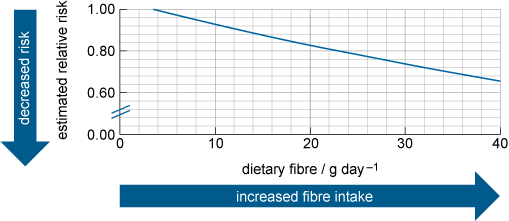4.4 Colorectal cancer
Colorectal cancer (CRC – cancer of the colon and/or rectum) is the third most common cancer worldwide and is often associated with dysbiosis of not just the gut bacteria, but also other microorganisms found in the gut microbiome, such as viruses, fungi, and Archaea (World Health Organization, 2023).
-
Question 21
What role does the gut microbiome have in the fibre consumed in the diet?
-
Fibre cannot be digested by the human host but is digested by some of the bacterial species of the gut microbiome (particularly Firmicutes). These bacteria then produce SCFAs as a by-product, which are beneficial for the other bacteria of the gut microbiome and human host.
SCFAs produced by the gut microbiome are also protective against colorectal cancer cells, helping to destroy them.
A study found that in colorectal cancer, the more fibre (particularly from cereal fibre and whole grains) consumed, the lower the estimated risk of developing colorectal cancer (Aune et al., 2011). This can be seen in Figure 28. As fibre consumption increases, the risk of developing colorectal cancer decreases.

-
Question 22
From Figure 28, what is the estimated risk of developing colorectal cancer if you consume around 20 g of fibre a day?
-
The relative risk is just above 0.80. This equates to an approximate 20% reduction in the likelihood of developing colorectal cancer.
A diet high in fibre helps to ensure that the Firmicutes bacteria survive and thrive to produce lots of beneficial SCFAs, but is also thought to be beneficial in reducing CRC risk in other ways:
- Fibre increases the bulk of the stool, so it travels through the gut more rapidly, reducing contact of the gut wall with cancer-causing substances (carcinogens).
- Fibre increases the feelings of fullness which helps to prevent overeating. Obesity is also linked to colorectal cancer, as well as 12 other types of cancer (Cancer Research UK, 2022).
As you may recall from earlier, the gut microbiome also affects how individuals respond to medications and recreational drugs. This includes chemotherapeutic agents and immunotherapy often used in the treatment of colorectal and other cancers. Therefore, the gut microbiome may have an impact on both the risk of developing CRC and how well an individual responds to the treatment (Wong, 2023).
